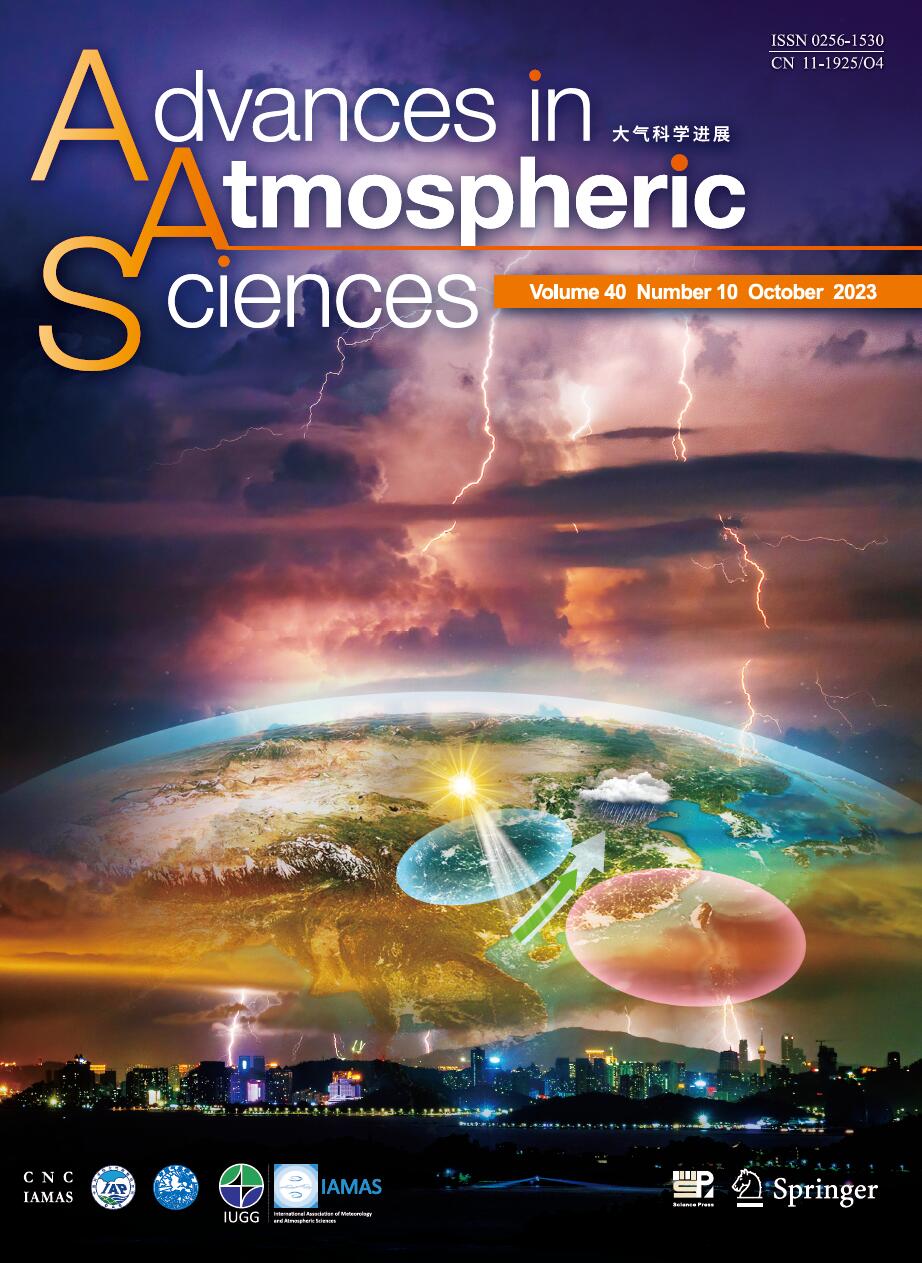| [1] |
Marcus JOHNSON, Ming XUE, Youngsun JUNG,
2024: Comparison of a Spectral Bin and Two Multi-Moment Bulk Microphysics Schemes for Supercell Simulation: Investigation into Key Processes Responsible for Hydrometeor Distributions and Precipitation, ADVANCES IN ATMOSPHERIC SCIENCES, 41, 784-800.
doi: 10.1007/s00376-023-3069-7
|
| [2] |
DAI Tie, SHI Guangyu, Teruyuki NAKAJIMA,
2015: Analysis and Evaluation of the Global Aerosol Optical Properties Simulated by an Online Aerosol-coupled Non-hydrostatic Icosahedral Atmospheric Model, ADVANCES IN ATMOSPHERIC SCIENCES, 32, 743-758.
doi: 10.1007/s00376-014-4098-z
|
| [3] |
LI Xiaohan, PENG Xindong, LI Xingliang,
2015: An Improved Dynamic Core for a Non-hydrostatic Model System on the Yin-Yang Grid, ADVANCES IN ATMOSPHERIC SCIENCES, 32, 648-658.
doi: 10.1007/s00376-014-4120-5
|
| [4] |
Yifan ZHAO, Xindong PENG, Xiaohan LI, Siyuan CHEN,
2024: Improved Diurnal Cycle of Precipitation on Land in a Global Non-Hydrostatic Model Using a Revised NSAS Deep Convective Scheme, ADVANCES IN ATMOSPHERIC SCIENCES, 41, 1217-1234.
doi: 10.1007/s00376-023-3121-7
|
| [5] |
ZUO Ruiting, WANG Liqiong, ZENG Qingcun, ZHANG Ming,
2005: Equilibrium Mechanism Analysis on the Physical Processes of IAP3.0, ADVANCES IN ATMOSPHERIC SCIENCES, 22, 525-533.
doi: 10.1007/BF02918485
|
| [6] |
SHI Xiangjun, WANG Bin, Xiaohong LIU, and Minghuai WANG,
2013: Two-moment Bulk Stratiform Cloud Microphysics in the Grid-point
Atmospheric Model of IAP LASG (GAMIL), ADVANCES IN ATMOSPHERIC SCIENCES, 30, 868-883.
doi: 10.1007/s00376-012-2072-1
|
| [7] |
REN Liliang, LI Chunhong, WANG Meirong,
2003: Application of Radar-Measured Rain Data in Hydrological Processes Modeling during the Intensified Observation Period of HUBEX, ADVANCES IN ATMOSPHERIC SCIENCES, 20, 205-211.
doi: 10.1007/s00376-003-0005-8
|
| [8] |
Wang Chunming, Wu Rongsheng, Wang Yuan,
2002: Interaction of Diabatic Frontogenesis and Moisture Processes in Cold-Frontal Rain-Band, ADVANCES IN ATMOSPHERIC SCIENCES, 19, 544-561.
doi: 10.1007/s00376-002-0085-x
|
| [9] |
WANG Pengyun, YANG Jing,
2003: Observation and Numerical Simulation of Cloud Physical Processes Associated with Torrential Rain of the Meiyu Front, ADVANCES IN ATMOSPHERIC SCIENCES, 20, 77-96.
doi: 10.1007/BF03342052
|
| [10] |
Hong WANG, Hengchi LEI, Jiefan YANG,
2017: Microphysical Processes of a Stratiform Precipitation Event over Eastern China: Analysis Using Micro Rain Radar data, ADVANCES IN ATMOSPHERIC SCIENCES, 34, 1472-1482.
doi: 10.1007/s00376-017-7005-6
|
| [11] |
HUANG Feng, LIU Shikuo,
2004: Physical Mechanism and Model of Turbulent Cascades in a Barotropic Atmosphere, ADVANCES IN ATMOSPHERIC SCIENCES, 21, 34-40.
doi: 10.1007/BF02915678
|
| [12] |
GAO Wenhua, ZHAO Fengsheng, HU Zhijin, FENG Xuan,
2011: A Two-Moment Bulk Microphysics Coupled with a Mesoscale Model WRF: Model Description and First Results, ADVANCES IN ATMOSPHERIC SCIENCES, 28, 1184-1200.
doi: 10.1007/s00376-010-0087-z
|
| [13] |
LIU Xiaoli, NIU Shengjie,
2010: Numerical Simulation of Macro- and Micro-structures of Intense Convective Clouds with a Spectral Bin Microphysics Model, ADVANCES IN ATMOSPHERIC SCIENCES, 27, 1078-1088.
doi: 10.1007/s00376-010-8088-5
|
| [14] |
Marcus JOHNSON, Youngsun JUNG, Daniel DAWSON, Timothy SUPINIE, Ming XUE, Jongsook PARK, Yong-Hee LEE,
2018: Evaluation of Unified Model Microphysics in High-resolution NWP Simulations Using Polarimetric Radar Observations, ADVANCES IN ATMOSPHERIC SCIENCES, 35, 771-784.
doi: 10.1007/s00376-017-7177-0
|
| [15] |
Sun Shufen, Li Jingyang,
2001: A Sensitivity Study on Parameterization Scheme of Snow Internal and Interfacial Processes in Snow Model, ADVANCES IN ATMOSPHERIC SCIENCES, 18, 910-928.
|
| [16] |
Xiaoqing WU, Xiaofan LI,
2008: A Review of Cloud-Resolving Model Studies of Convective Processes, ADVANCES IN ATMOSPHERIC SCIENCES, 25, 202-212.
doi: 10.1007/s00376-008-0202-6
|
| [17] |
Zhang Daomin, Sheng Hua, Ji Liren,
1990: Development and Test of Hydrostatic Extraction Scheme in Spectral Model, ADVANCES IN ATMOSPHERIC SCIENCES, 7, 142-153.
doi: 10.1007/BF02919152
|
| [18] |
Ping WU, Yihui DING, Yanju LIU,
2017: Atmospheric Circulation and Dynamic Mechanism for Persistent Haze Events in the Beijing-Tianjin-Hebei Region, ADVANCES IN ATMOSPHERIC SCIENCES, 34, 429-440.
doi: 10.1007/s00376-016-6158-z
|
| [19] |
Wang Guomin,
1993: One Possible Mechanism for the Principal Mode of Atmospheric Low-Prequency Variability in the Northern Hemisphere Winter, ADVANCES IN ATMOSPHERIC SCIENCES, 10, 54-60.
doi: 10.1007/BF02656953
|
| [20] |
WEN Lijuan, Nidhi NAGABHATLA, Lü Shihua, Shih-Yu WANG,
2013: Impact of Rain Snow Threshold Temperature on Snow Depth Simulation in Land Surface and Regional Atmospheric Models, ADVANCES IN ATMOSPHERIC SCIENCES, 30, 1449-1460.
doi: 10.1007/s00376-012-2192-7
|















 AAS Website
AAS Website 
 AAS WeChat
AAS WeChat 
 DownLoad:
DownLoad: